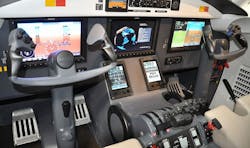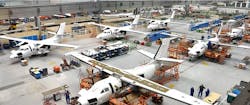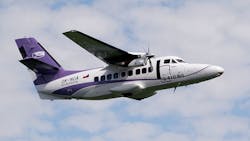KUNOVICE, Czech Republic. Aircraft Industries in Kunovice, Czech Republic, has begun series production of its L 410 New Generation (NG) aircraft after having won certification from the European Aviation Safety Agency (EASA) and the U.S. Federal Aviation Administration (FAA).
Production started with the construction of the first aircraft, which will be finished by the end of this year. EASA officials certified the L 410 NG aircraft on 19 December 2017; FAA officials certified the aircraft on 10 January 2018.
Development of the New Generation model began in April 2010 under the terms of the MOSTA or “modernization of small transport aircraft with the aim to increase the effectiveness and economy of operation” project.
The goal of the MOSTA project is to strengthen and improve the technical, operational, and economical parameters of the aircraft, increase operational safety, decrease the negative impact on the environment, and decrease the labor input of the aircraft production.
The MOSTA project, which was supported by the Czech Ministry of Industry and Commerce within the TIP program, enabled cooperation with other Czech companies and institutions, including: Avia Propeller, s.r.o.; EVEKTOR, spol. s r.o.; GE Aviation Czech s.r.o; VR Group, a.s.; JIHLAVAN, a.s.; Jihostroj a.s.; MESIT pristroje spol. s r.o.; SVUM a.s.; UNIS, a.s.; Vysoke uceni technicke in Brno (Technical University in Brno); Aero Vodochody, a.s.; and VZLU a.s.
The total cost of the project reached over CZK 568 million, inclusive of resources from the Ministry of Industry and Commerce – approx. CZK 237 million. The project was officially completed on 29 March 2017.
“This is the successful completion of a completely unique project that was both technically and organisationally demanding,” says Aircraft Industries CEO Ilona Plšková. “This success is an obvious demonstration of the Czech Republic's competences in the field of aviation and opens up new opportunities for deeper cooperation at the European and also global level.”
“The L 410 NG excels with a number of advantages when compared to the currently produced L 410 UVP-E20,” says L 410 NG Project Manager Miroslav Pešák. “The luggage compartment has doubled, and the airplane can carry 400 kg more cargo. The aircraft has a new integral wing with an almost two-fold fuel capacity. The range has grown to almost double (to 2,570 km), with endurance of 10.5 hours.”
The aircraft has a GE H85-200 engine with a take-off power of 850 horsepower (HP) and AV 725 propellers. The engine is equipped with a new reduction gear that reduces noise due to a lower propeller speed. The L 410 NG achieves higher cruising speeds of up to 417 km/h true air speed (TAS).
To improve flight safety and the comfort of crew, the pilot cabin was upgraded with Glass Cockpit technology from the Garmin Company, specifically by G3000 avionics.
“The upgraded L 410 NG will have greater potential for customers requiring long-haul flights or patrol flights,” Aircraft Industries General Director Ilona Plskova adds. “Due to better airplane characteristics and higher comfort compared to the previous model, we expect greater interest from customers all over the world.”
The use of the L 410 NG is anticipated in island states, such as Indonesia, Papua New Guinea, and Japan, where refueling on remote islands is problematic and a long range is one of the most important parameters. Further potential exists for remote routes without the possibility to refuel at the destination airport, and where the aircraft can be used by mining companies to transport workers and freight to inaccessible mining areas.
In 2010, the company started to modernize the L 410 UVP-E20 with the aim of increasing its efficiency and economizing its operation. Modernized aircraft, which carries the nameL 410 NG, remains in the “commuter category” and its passenger capacity is 19 and two pilots.
Modernized aircraft is characterized by many changes. Fundamental changes include: MTOW increase, payload increase, essential double enlargement of front luggage compartment because of aircraft nose prolongation, and new wing structure with integral fuel tank and its production technology. Integral fuel tanks enable significant increase of fuel capacity.
It uses a GE H85-200 BC04 power plant together with AV 725 propellers. Operators, by means of these crucial changes, receive an aircraft with improved parameters and utility characteristics such as range extension, cruising speed increase and radical engine “hot and high performance” improvement.
Implementation of “damage tolerance” maintenance philosophy will significantly increase the operation life of the aircraft. The company will implement a full glass cockpit into pilot cabin. The passenger cabin will undergo significant modernization, which, as a result, will offer an environment that passengers are used to from higher category aircrafts.
Development of the L 410 NG is realized in terms of theMOSTA project, in which other Czech companies and research or educational institutions are cooperating. The project is supported by state resources by means of the Ministry of Industry and Trade.
Composites, which will be used on the L 410 NG, are being developed by the INKOM project, also financially supported by the Ministry of Industry and Trade.
Maiden flight of L 410 NG was accomplished on 29 July 2015.



